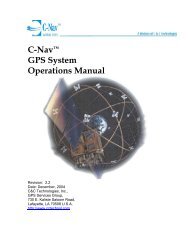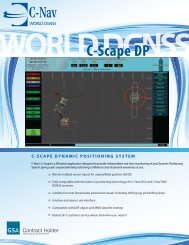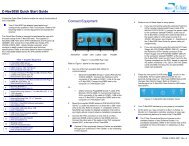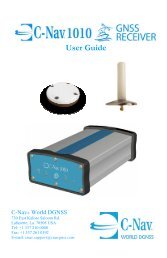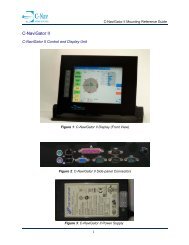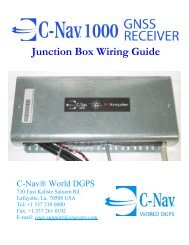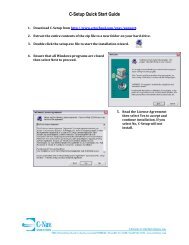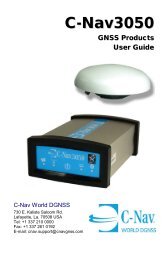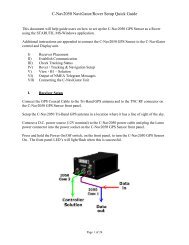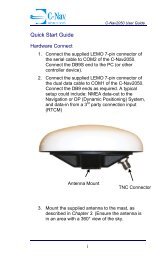Guidelines for the use of GNSS in surveying and mapping
Guidelines for the use of GNSS in surveying and mapping
Guidelines for the use of GNSS in surveying and mapping
Create successful ePaper yourself
Turn your PDF publications into a flip-book with our unique Google optimized e-Paper software.
GPS (Global Position<strong>in</strong>g System)<br />
The United States <strong>GNSS</strong> system.<br />
GPS-ICD-200<br />
The GPS <strong>in</strong>terface control document is a US<br />
government document that conta<strong>in</strong>s <strong>the</strong> full<br />
technical description <strong>of</strong> <strong>the</strong> <strong>in</strong>terface between <strong>the</strong><br />
satellites <strong>and</strong> <strong>the</strong> <strong>use</strong>r. GPS receivers must comply<br />
with this specification if <strong>the</strong>y are to receive <strong>and</strong><br />
process GPS signals properly.<br />
GPS week<br />
GPS time started at Saturday/Sunday midnight on<br />
6 January 1980 <strong>and</strong> <strong>the</strong> weeks are numbered from<br />
that date, up to 1024 weeks. The first week<br />
‘rollover’, <strong>the</strong> start <strong>of</strong> <strong>the</strong> next renumber<strong>in</strong>g,<br />
occurred on 21 August 1999.<br />
Gravitational constant<br />
The proportionality constant <strong>in</strong> Newton’s Law <strong>of</strong><br />
Gravitation is G = 6.672 x 10 -11 m 3 kg -1 s -2 .<br />
Half-wave<br />
Measurements made us<strong>in</strong>g L2 squared<br />
measurements. The squar<strong>in</strong>g process results <strong>in</strong> only<br />
half <strong>of</strong> <strong>the</strong> orig<strong>in</strong>al L2 wavelength be<strong>in</strong>g available, a<br />
doubl<strong>in</strong>g <strong>of</strong> <strong>the</strong> orig<strong>in</strong>al L2 frequency.<br />
HDOP (Horizontal dilution <strong>of</strong> precision)<br />
See DOP <strong>and</strong> PDOP.<br />
Height – ellipsoidal<br />
The distance above or below <strong>the</strong> ellipsoid<br />
measured along <strong>the</strong> normal to <strong>the</strong> ellipsoid at that<br />
po<strong>in</strong>t. Not <strong>the</strong> same as elevation above sea level.<br />
<strong>GNSS</strong> receivers output position-fix height as <strong>the</strong><br />
height above <strong>the</strong> ITRS89 ellipsoid.<br />
HOW (H<strong>and</strong>over word)<br />
The word is <strong>the</strong> <strong>GNSS</strong> message that conta<strong>in</strong>s time<br />
synchronisation <strong>in</strong><strong>for</strong>mation <strong>for</strong> <strong>the</strong> transfer from <strong>the</strong><br />
C/A code to <strong>the</strong> P-code.<br />
IERS<br />
International Earth Rotation Service.<br />
Initialisation<br />
The moment when a rover <strong>GNSS</strong> receiver <strong>in</strong> a high<br />
precision real-time dynamic system (RTK) solves<br />
<strong>the</strong> <strong>in</strong>teger ambiguity <strong>and</strong> ga<strong>in</strong>s a real-time high<br />
precision fixed basel<strong>in</strong>e solution.<br />
Integer bias search<br />
The biases calculated <strong>in</strong> <strong>the</strong> float solution are fixed<br />
to <strong>in</strong>tegers. A search is <strong>the</strong>n undertaken to f<strong>in</strong>d<br />
closely related sets <strong>of</strong> <strong>in</strong>tegers. These sets are<br />
compared to <strong>the</strong> <strong>in</strong>itial set by divid<strong>in</strong>g <strong>the</strong> sum <strong>of</strong><br />
<strong>the</strong> squares <strong>of</strong> residuals <strong>of</strong> <strong>the</strong> trial set by that <strong>of</strong><br />
<strong>the</strong> orig<strong>in</strong>al set. A strong data set allows only one<br />
set <strong>of</strong> <strong>in</strong>tegers, <strong>and</strong> produces a ratio factor greater<br />
than 3.0. A weak data set may accept several<br />
different sets <strong>of</strong> <strong>in</strong>tegers with only small changes <strong>in</strong><br />
its sum <strong>of</strong> <strong>the</strong> squares fit, thus produc<strong>in</strong>g a small<br />
ratio factor.<br />
Integer bias terms<br />
The receiver counts <strong>the</strong> radio waves from <strong>the</strong><br />
satellite, as <strong>the</strong>y pass <strong>the</strong> antenna, to a high degree<br />
<strong>of</strong> accuracy. However, it has no <strong>in</strong><strong>for</strong>mation on <strong>the</strong><br />
number <strong>of</strong> waves to <strong>the</strong> satellite at <strong>the</strong> time it<br />
started count<strong>in</strong>g. This unknown number <strong>of</strong><br />
wavelengths between <strong>the</strong> satellite <strong>and</strong> <strong>the</strong> antenna<br />
is <strong>the</strong> <strong>in</strong>teger bias term.<br />
Integrated Doppler<br />
A measurement <strong>of</strong> Doppler shift frequency <strong>of</strong> phase<br />
over time.<br />
Ionospheric delay<br />
The ionosphere is a non homogeneous (both <strong>in</strong><br />
space <strong>and</strong> time) <strong>and</strong> dispersive medium. A wave<br />
propagat<strong>in</strong>g through <strong>the</strong> ionosphere experiences<br />
variable delay. Phase delay depends on electron<br />
content <strong>and</strong> affects carrier signals. Group delay<br />
depends on dispersion <strong>in</strong> <strong>the</strong> ionosphere as well,<br />
<strong>and</strong> affects signal modulation. The phase <strong>and</strong><br />
group delay are <strong>of</strong> <strong>the</strong> same magnitude but<br />
opposite sign.<br />
ITRF (International terrestrial reference frame)<br />
See Reference frame.<br />
JPO<br />
Jo<strong>in</strong>t Program Office <strong>for</strong> GPS located at <strong>the</strong> USAF<br />
Space Division at El Segundo, Cali<strong>for</strong>nia. The JPO<br />
consists <strong>of</strong> <strong>the</strong> USAF Program Manager <strong>and</strong><br />
Deputy Program Managers represent<strong>in</strong>g <strong>the</strong> Army,<br />
Navy, Mar<strong>in</strong>e Corps, Coastguard, National Imagery<br />
<strong>and</strong> Mapp<strong>in</strong>g Agency (NIMA) <strong>and</strong> NATO.<br />
Kalman filter<br />
A numerical method <strong>use</strong>d to track a time-vary<strong>in</strong>g<br />
signal <strong>in</strong> <strong>the</strong> presence <strong>of</strong> noise. If <strong>the</strong> signal can be<br />
characterised by some number <strong>of</strong> parameters that<br />
68 | GUIDELINES FOR THE USE OF <strong>GNSS</strong> IN LAND SURVEYING AND MAPPING





